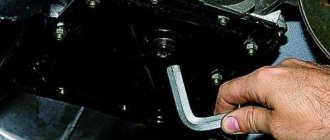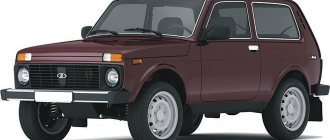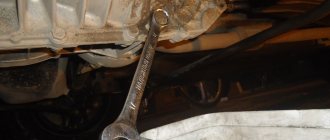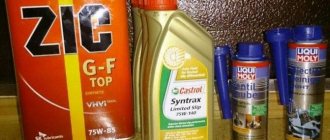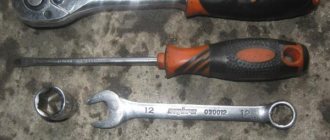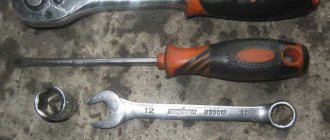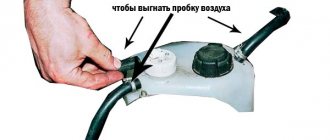Changing the oil in the transfer case Niva 21214
The Niva 21214 car is distinguished by its increased cross-country ability on roads. The car has an engine that has a volume of 1.7 liters, which complies with Euro-4 standards. The transmission system includes a transfer case with a crankcase ventilation system. All components on the VAZ 21214, just like on the VAZ 21213, are characterized by a long service life. It is important to take proper care of the automotive system and select high-quality oil for the Niva.
The Niva SUV (VAZ 2121), which has all-wheel drive and is equipped with a manual transmission, is capable of producing 75 horsepower.
Selecting gearbox oil
Which oil to choose? Transmission oils come in a wide range. You should pay attention to fuel that has the following viscosity: 75W-90, 85W-90. In particular, you can choose Lukoil 80W90 gear oil (GL5 class). When operating vehicles in winter, you should purchase 70W-90 oil, as it has a low viscosity. Semi-synthetic options are also suitable for refueling Niva 21213. It is better to carry out replacement at a specialized service center.
How much oil to fill? Approximately 0.8 liters of oil must be added to the Niva distributor. 1.6 liters of transmission fluid is poured into its high-speed box.
Before choosing a transmission fluid, you should always carefully study its composition.
The need to change transmission oil
To change the oil on a Niva, the car must be warmed up (to ensure good fluid fluidity). The machine is placed on an inspection hole; a special container should be placed under the drain hole into which the waste liquid will drain. To open the drain and fill plug, you should use a hexagon. Also, as an additional tool, you will need a special syringe, which is used to fill the transfer case with fuel.
Changing the oil in the transfer case (Niva 21214 / 21213). Main stages:
- The drain plug is unscrewed.
- The remaining oil is poured into the container.
- Any contamination on the plug must be eliminated.
- The drain plug is screwed in.
- The top plug is unscrewed to fill in new oil using a syringe.
- The plug is screwed in.
The peculiarity of the gearbox is that it has a built-in magnet. Its function is to attract small metal debris that may be present in the fuel.
When replacing fuel, the crankcase must be flushed. This procedure helps to extend the operational life of the box. Flushing is required if the drained oil is heavily contaminated.
The frequency of changing fuel for the transmission is affected by the mileage of the Niva 21214 (21213) and the conditions under which it is used. When making frequent off-road trips, the need to change the oil for the transfer case and gearbox may arise up to 50,000 km.
The need to add a new lubricant to the box can be indicated by the fact that the gearbox began to overheat and characteristic noises appeared on its side during movement.
How much antifreeze or antifreeze is needed in the car cooling system:
- VAZ 2101 - 8 liters;
- VAZ 2102 - 8 liters;
- VAZ 2103 - 8.6 liters;
- VAZ 2104 - 8.5 liters;
- VAZ 2105 - 8.6 liters;
- VAZ 2106 - 8.6 liters;
- VAZ 2107 - 8.6 liters;
- VAZ 2108 - 7.8 liters;
- VAZ 2109 - 7.8 liters;
- VAZ 21099 - 7.8 liters;
- VAZ 2113, 2114, 2115 - 7.8 liters;
- VAZ 2110, 2111, 2112 - 7.8 liters for both 8 and 16 valve engines;
- VAZ 21213 “NIVA” - 10.7 liters;
- VAZ 2111 “OKA” - 4.8 liters;
- Lada Granta VAZ 2190 - 7.8 liters;
- Lada Kalina VAZ 23009 - 7.84 liters;
- Lada Priora - 7.84 liters;
- Lada Vesta - 7.84 liters;
- Lada Xray (X Ray) - 7 liters.
Changing the oil in the Niva 21213, 2121 gearbox
According to the recommendations of the VAZ manufacturer, the oil level should be checked after every forty to sixty thousand kilometers, but practice shows that it is better to do this at least twice as often. If, during inspection, you find that the oil is dirty and smells of burning, this means that it needs to be changed immediately. This procedure is easy to carry out yourself. Changing the oil in Niva 21213 is done in exactly the same way as in 2121.
Changing the oil in the gearbox.
The entire operation must be carried out in the inspection hole, and before the operation you need to drive eight to ten km so that the oil warms up.
If you are changing the oil for the first time, the first thing you need to do is find the filler neck. It is located on the left side and may not be immediately noticeable due to the gimbal. Do not confuse it with the technological plug, which is located on the right.
Having found the neck, take a 12mm hex and unscrew the drain plug.
Place a container near the neck and let the oil drain.
Next, clean the plug magnet from dirt and metal particles and screw the plug back on.
Now take the 17 key and unscrew the filler plug.
Then, using a special syringe, fill the oil to the bottom edge of the hole and tighten the plug.
All.
By the way, sometimes it happens that the box becomes clogged with metal shavings or the seals begin to leak. In such cases, you just need to add oil.
*For vehicles with a fuel injection system with a catalytic converter and an oxygen concentration sensor. **Recommended application temperature range: 0W-30 below -35 o C...+25 o C 0W-40 below -35 o C...+30 o C 5W-30 -30 o C...+25 o C 5W-40 -30 o C...+35 o C 10W-30 -25 o C...+25 o C 10W-40 -25 o C...+35 o C 15W-40 -20 o C...+45 o C 20W-50 -15 o C ...above +45 o C ***Recommended application temperature range: 75W-80 -40 o C...+35 o C 75W-85 -40 o C...+35 o C 75W-90 -40 o C...+45 o C 80W-85 -26 o C...+35 o C 80W-90 -26 o C...+45 o C 85W-90 -12 o C...+45 o C and above
Fill
To fill in new antifreeze, you don’t have to do anything complicated.
You just need a special watering can. Many containers in which antifreeze is sold are not particularly convenient for pouring directly from them. Use a funnel to avoid spilling coolant. It is extremely important to know exactly how much antifreeze is in the cooling system. The coolant for the VAZ 2109 requires 7.8 liters. Therefore, antifreeze should be purchased in 8-liter containers.
- Take a watering can and insert it into the neck of the expansion tank. This way you won’t spill precious grams of antifreeze.
- Check that all drain plugs are securely tightened. Otherwise, the coolant will simply spill out onto the floor and you will have to buy new coolant.
- Start gradually pouring in new antifreeze.
- Stop periodically for 1-2 minutes so that the liquid has time to distribute throughout the system.
- After filling the system, add coolant to the middle of the expansion tank level.
- Next, the most important thing is to get rid of the air that has entered the cooling system.
- Air accumulates in the upper pipe. To remove it, you just need to squeeze the upper pipe several times. Squeeze until you feel liquid appear inside.
- Bleed the cooling system. To do this, use a screwdriver or a size 8 wrench to unscrew the clamp that holds the return hose to the CO expansion tank (return).
- Now close the fitting with your finger, onto which the return line is put, so that air cannot escape from there.
- Next you need to blow into the expansion tank. Just imagine that you are trying to inflate the tank like a balloon.
- This will create pressure and coolant will begin to flow from the expansion tank into the CO, and excess air will escape through the return.
- As soon as antifreeze begins to flow out of the return line, the procedure can be stopped.
- Replace the return line and tighten the clamp.
- Reconnect the negative terminal of the battery, close the cap of the expansion tank and check the quality of the work done.
Also interesting: Niva Chevrolet installation of air conditioning - Auto magazine MyDucato
It is not recommended to begin active operation of the vehicle without checking.
Power unit
The engine installed on the modern model of the Niva 21213 (214) car was inherited from its Soviet progenitor - the VAZ 2121, and in terms of fluid volumes they are almost identical:
- Liquid cooling system. Filled with antifreeze in an amount of 10.7 liters with a freezing point not higher than -40 ° C. The capacity of the interior heating radiator is also included in this volume.
- Crankcase. Motor oils are poured here, the brand of which depends on the operating conditions. Capacity: 3.75 liters, including oil filter filling.
The viscosity of the oil poured into the Niva engine must correspond to the outdoor temperature at which the car is operated. Possible modes and suitable oil brands are shown in the table:
| Lower limit of ambient temperature, °C | -20 | -25 | -25 | -30 | -30 | -15 | -35 | -30 |
| Upper limit of ambient temperature, °C | +45 | +35 | +45 | +35 | +45 | +45 | +25 | 30 |
| SAE lubricant viscosity grade | 15W-40 | 10W-30 | 10W-40 | 5W-30 | 5W-40 | 20W-40 | 0W-30 | 0W-40 |
When flushing the power unit during the process of replacing liquid lubricant, the same amount of flushing oil (3.75 l) is used, taking into account the size of the filter. Replacement is carried out after 8-12 thousand kilometers, depending on the quality of the oil. Flushing is usually performed after 3 engine lubricant changes. During operation, it is important to monitor the oil level in the engine crankcase using a special dipstick. If the level drops below the Min mark, it is urgent to add lubricant to the engine of the same viscosity as was previously filled.
Antifreeze needs to be updated at least once every 3 years or according to the degree of wear of the fluid. It is not recommended to dilute antifreeze with distilled water, either in winter or summer. In winter, the diluted liquid may freeze, and during the summer heat it may boil ahead of time, which will lead to overheating of the engine.
Injection 21214 eats more than VAZ 2121
Changing the oil in a Priora automatic transmission
Interior of a domestic SUV
The injector on 21214 has the following operating scheme: data on air flow, crankshaft movement, coolant temperature, engine detonation, fuel consumption, voltage in the on-board network, etc. is received from vehicle components to a number of sensors. After receiving the information, the control unit gives signals about the order of fuel supply, the operation of the ignition system, the diagnostic system, the operation of the idle air control. The injector changes injection parameters depending on the data received.
This system includes such components as sensors, a controller, the injector itself (nozzles), a fuel pump, and a pressure regulator. In it, the pump supplies fuel, the pressure regulator maintains the difference between the pressure in the injectors and the air gap in the intake manifold. And the ECU processes the information received from the sensors.
Injection engines of Niva 21214 cars, if not properly maintained, lose their efficiency, increasing fuel consumption, and often begin to stall. As a rule, the problem lies in dirty engine injectors, which cause poor mixture formation and atomization of gasoline. Cleaning the injectors can be done independently by purchasing additional materials worth about 500 rubles (including: a diamond wrench on “8”, a carburetor cleaner, a vacuum hose for the distributor, a syringe with an outlet diameter of 1 cm, an electrical cable with a toggle switch and a light bulb, rubber rings injectors, 8 pieces, O-rings for fuel pipes - 4 pieces).
At a car service center this service costs about 1,500 rubles. The injector is considered a good fuel injection system, but it is expensive, difficult to repair, requires high-quality gasoline, special diagnostic equipment and expensive repair maintenance. Therefore, many VAZ 2121 owners prefer a carburetor.
The Niva 21213 and 21214 models are more “gluttonous” than the Niva 2121. The engine on them consumes 11.5 liters in the city, 8.3 liters on the highway, and about 10.5 liters per hundred kilometers in the combined cycle according to the manufacturer’s version . In practice, for some taiga hunters, the car “eats” about 16 liters of gasoline, and in urban conditions - 13-14 liters per “hundred”.
Reinforced suspension
Engine 2130, first released in 1993, is found in the Niva 2131. Its technical parameters are as follows:
- cast iron cylinders;
- food - carburetor or injector;
- in-line type;
- four cylinders, each of which has two valves;
- cylinder diameter - 8.2 cm;
- Engine volume on model 2131 is 1.8 liters;
- power at 5200 rpm - 82 horsepower;
- torque at 3200 rpm is 139 Nm;
- engine weight 122 kg;
- oil is poured in the same volume as on the VAZ 2121 Niva;
- oil consumption from 0.7 liters per 1000 kilometers;
- service life according to the plant - 80 thousand km, according to users up to 180 thousand km
Other liquids and fuels and lubricants
Every car enthusiast should know by heart the maximum fuel capacity of his car. The fuel tank of the VAZ 21213 has a capacity of 42 liters, including reserve. The reserve refers to the amount of fuel remaining in the tank after the yellow warning light on the instrument panel turns on. The reserve amount is at least 5 liters. The car must be fueled with gasoline whose octane number is in the range of 91-93.
The car has a number of refueling tanks that the owner must monitor during operation:
- brake system with expansion tank, total capacity - 0.515 l;
- hydraulic clutch drive with expansion tank - 0.2 l;
- 2 plastic tanks with a volume of 2 liters each contain a supply of windshield and rear window washer fluid.
The clutch release drive and brake system are filled with hydraulic brake fluid (the most popular is DOT-4). It should be changed at least every 3 years, because the liquid has the ability to absorb water vapor contained in the air. As a result, all steel parts of the system in contact with it begin to corrode, which leads to complete or partial failure of the brakes.
If there is a leak in the clutch or brake system, the level in the expansion tanks decreases, so constant monitoring is required over them.
The level of brake fluid in the reservoirs must be maintained no lower than the corresponding mark on the plastic body of the container.
Liquid or clean water for washing glass is added if necessary; in winter, a non-freezing option is required. Otherwise, the ice will not only destroy the tubes, but also damage the electric pump.
Various thick lubricants are also used for maintenance and lubrication of the Niva:
- Litol - a composition for lubricating highly loaded bearing parts;
- CV joints-4 - lubricant for the hinges of the front axle shafts and door opening limiters;
- ShRB-4 is designed for processing ball joints and steering rods.
The list of refueling containers is useful for novice car enthusiasts who bought a used car with a lost instruction manual. The operation of such a car should begin with the replacement of all fluids and oils.
Niva Chevrolet: filling tanks, features, purpose
The number of these elements in each vehicle may vary. In addition, it is important to have a clear understanding of the location, types, engine and transmission oil used, types of lubricants and fluids.
- After all, Chevrolet Niva filling tanks must be filled taking into account the plant’s recommendations so that all systems can fully operate.
- Video
- FILLING CAPACITIES, OILS AND LIQUIDS.
- Oils and liquids
- Motor gasoline with octane number 93, 95**
- Engine cooling system
- (including interior heating system)
- Coolant with a freezing point no higher than –40°C
- Latest recommendation from AvtoVAZ
- Sintec Antifreeze Lux G12
- Engine lubrication system
- (including oil filter)
- Motor oils (with API quality level: SG, SH, SJ, SL,SM, SN)
- Gearbox housing
- Gear oils with quality level according to API GL-5 and viscosity 75W-90
- Rear axle housing
- Steering gear housing
- Transfer case housing
- Front axle housing
- Hydraulic clutch system
- DOT-4 brake fluid
- Hydraulic brake system
- Windshield and headlight washer reservoir
- A mixture of water and windshield washer fluid
- Rear window washer reservoir
- Power steering reservoir
- Fluid for refilling the hydraulic steering system Pentosin SHF11S
- * For VAZ-2131 cars and its modifications.
- **For vehicles with fuel injection system equipped with an exhaust gas converter
The recording is more for myself, but maybe it will be useful to someone else. Since after the purchase I only changed the oil in the engine, and it’s not at all clear what and how much in the transmission, I’m thinking about changing the oils in the gearbox, transfer case and axles. It would be good to know what kind of transmission oil to fill in to reduce the howling of the transfer case.
Also interesting: Knock in the engine @ Niva 4×4
Fuel tank 58.
0 l Engine cooling system 8.0 l Engine lubrication system 3.75 l Gearbox housing 1.6 l Transfer case housing 0.79 l Front axle housing 1.15 l Rear axle housing 1.3 l Brake hydraulic system 0.5 l Clutch release hydraulic system 0.15 Windshield washer reservoir 5.0 l Tailgate washer reservoir 2.0 l Front shock absorber 0.15 l Rear shock absorber 0.215 l Power steering 1.7 l Air conditioning: refrigerant 0.650 kg
Conditioner: oil 0.22 l
- Places for lubrication, filling, processing
- Motor oils type SUPER (classification according to SAE; API) Engine lubrication system Viscosity class according to SAE: 5W-30: from –25 to 20 С5W-40: from –25 to 35 С10W-30: from -20 to 30 С10W -40: from -20 to 35 С15W-40: from –15 to 45 С20W-40: from –10 to 45 Level of performance properties: according to API SG, SH, SJ according to ASEA A2
- according to CCMC G3, G4
- Transmission oils (classification according to SAE; API) Gearbox, Transfer case Viscosity grade according to SAE: 75 W-90; 80 W-85; 80 W-90; Level of performance properties: according to API: GL-4 or universal: GL-4/ GL-5 Front axle, Rear axle, Steering gear Viscosity grade according to SAE: 80 W-90; 85 W-90; Level of performance properties: according to API: GL-5 or universal: GL-4/ GL-5
- Power steering: Pentosin Hidraulik Fluid CHF11S VW52137
How to avoid falling asleep while driving on the highway
GreasesFront wheel drive joints CV joints-4M, SPECTROL CV joints MoS2 TU 0254-001-0014882Front suspension ball joints, Steering rod joints ShRB-4 TU 38.
USSR-201-143 Joints for cardan shafts Litin 2 TU 0254-311-00148820 Splined joints for cardan shafts 158 TU 38.
Dowcorning
Pressure regulator DT-1 TU 38-USSR-201-116
Brake and clutch hydraulic drive system Brake fluids type DOT-4 SAE J 1703, FMSS116
In this article we will talk about how to change the oil in the gearbox, transfer case and axles of a Chevrolet Niva. The use of high-quality lubricants for vehicles plays an important role in the operation of any car. The most common process for proper vehicle operation is the oil change process. It is possible to change the oil yourself, without resorting to the help of auto service employees, while significantly saving money.
Choosing engine oil is a responsible task on which the service life of the power plant depends. This procedure is no less important than the oil change process itself. Oil should be selected according to the parameters and tolerances specified in the operating instructions.
You cannot make a mistake in your choice, as this mistake can result in a serious technical breakdown, and incompatible oil can cause a major overhaul of the engine.
In this article, using the example of the popular Chevrolet Niva SUV, we will pay attention to the most important parameters of motor oil, and also consider the best brands of oils and how much oil should be filled.
Also interesting: Dynamic vibration damper @ Niva 4×4
After all, Chevrolet Niva filling tanks must be filled taking into account the plant’s recommendations so that all systems can fully operate.
Gas tank characteristics
Niva Chevrolet fuel tank capacity is almost 60 liters. The technical description for the car indicates the exact figure for this indicator - 58 liters. Such a tank is characterized as large, which adds additional convenience when operating the vehicle. The car consumes AI-92 or Premium AI-95 gasoline at a consumption of 8-9 liters per 100 km. Which is the average for similar models.
Features of the Chevrolet Niva gas tank
- The tank is located directly under the rear seat;
- In the upper plane there is a small hatch, below which there is a fuel pump;
- The fuel refueling indicator is located on the dashboard of the car. It helps control the required amount of gasoline for refueling.
Transmission
The Niva 4x4 transmission system has the following filling volumes:
- transfer case - 0.79 l;
- gearbox - 1.6 l;
- rear axle - gearbox - 1.3 l;
- front axle - crankcase - 1.15 l;
- steering column - crankcase - 0.18-0.2 l.
As with the operation of a power unit, under different temperature conditions, transmission units and assemblies are filled with oils of different viscosities, which is reflected in the table:
| Lower limit of ambient temperature, °C | -15 | -25 | -25 | -30 | -40 |
| Upper limit of ambient temperature, °C | +45 | +45 | +35 | +45 | +35 |
| SAE lubricant viscosity grade | 85W-90 | 80W-90 | 80W-85 | 75W-90 | 75W-80 75W-85 |
As stated in the operating instructions, transmission lubricants need to be changed once every 30 thousand km. mileage At the same time, replacement is not provided for in the steering mechanism housing, only an addition through the top plug. The “native” oil for Zhiguli transmission units is considered to be TAD17I.
Transmission oils have good penetrating ability. Therefore, poorly clamped plugs and worn gaskets of units begin to gradually leak lubricant. In such situations, it is allowed to add oil of the same viscosity class and, preferably, the same manufacturer. If you do not top up during a leak, the lubricant level in the unit will decrease, which will lead to accelerated wear of expensive mechanisms.
